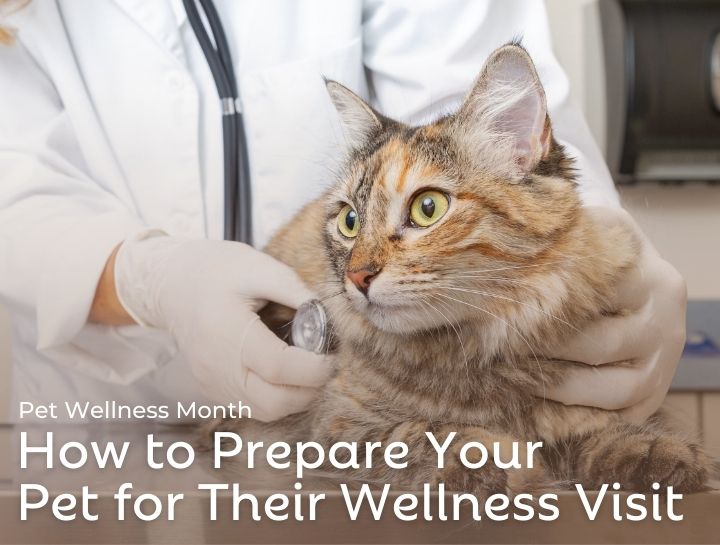Cat Wellness Visits: How to Prepare

October is National Pet Wellness Month! Wellness exams are given when a cat is healthy to prevent life-threatening diseases that can be difficult—and expensive—to treat. Scheduling regular wellness exams is one of the most important things you can do to keep your cat happy and healthy throughout its life.
How Often Does My Cat Need a Wellness Exam?
The frequency of your cat’s wellness exams will depend on its age, but most full-grown cats need to be seen annually or every six months. After their first visit (usually at 6-8 weeks), kittens will need wellness exams every 3-4 weeks until they are about 5 months old.
What Does a Wellness Exam Include?
Lifestyle and Health History
Before the physical exam, a team member will ask you about your pet’s diet, behavior, lifestyle, and health history. This is a great time to share any questions or concerns with your veterinary team.
Physical Exam
In between giving treats and cuddles, our team will get a full picture of your cat’s health from head-to-tail by:
- Measuring its weight, pulse, and rate of breathing
- Listening to the heart and lungs
- Checking joints, eyes, ears, skin, and teeth
- Observing your cat’s alertness and reflex responses
- Feeling the organs and lymph nodes in the abdomen
- Checking the rest of your cat’s body for unusual lumps and/or pain
Routine Diagnostic Tests
Depending on your cat’s age and medical history, your veterinarian may recommend the following tests:
-
Heartworm testing (blood parasite screening).
-
Fecal testing. This allows the veterinarian to check for the presence of internal parasites such as hookworms, round worms, and whipworms.
-
Blood work. Blood tests screen for infection or disease that may not otherwise be detected through a physical examination. Blood work also allows a veterinarian to assess your pets’ health comprehensively.
Vaccinations
Lastly, your cat’s wellness exam will include preventative care, like vaccinations. Kittens are usually protected from infectious diseases by their mother’s milk if she has been adequately vaccinated herself. However, this protection only lasts for a short while.
-
Kittens should be vaccinated at 9, 12, and 15 weeks.
-
Boosters should be given 12 months after the date of the last vaccination.
-
If you have an older pet, your veterinarian can advise you on the correct vaccination schedule to follow.
Cats should be routinely vaccinated against:
- Feline calicivirus
- Feline herpes virus
- Feline infectious enteritis
- Feline leukemia virus (kittens and immune-compromised cats)
How Should I Prepare for My Cat’s Wellness Exam?
-
Gently introduce your cat to its carrier. Keeping the carrier out and open in your home (and stocked with some favorite toys and treats) will help lower your cat’s stress when it’s time for a vet visit.
-
Choose a cat-only clinic. The sights and sounds of other species can stress your cat during a vet visit. Cat-friendly practices make for a more enjoyable experience for you and your cat.
-
Keep your cat calm. Treats, pheromone spray, or a familiar blanket from home can help keep your cat calm while they’re at the clinic.
Scheduling Your Cat’s Next Wellness Exam
The old saying is true: an ounce of prevention is better than a pound of cure. Not only do regular wellness exams keep your cat healthy and happy, but they will also likely allow you to save on veterinary expenses over the long term. Meadows Cat Hospital is here to help your cat live a long and happy life. Call us at (425) 392-8770 to request an appointment or book online today!
